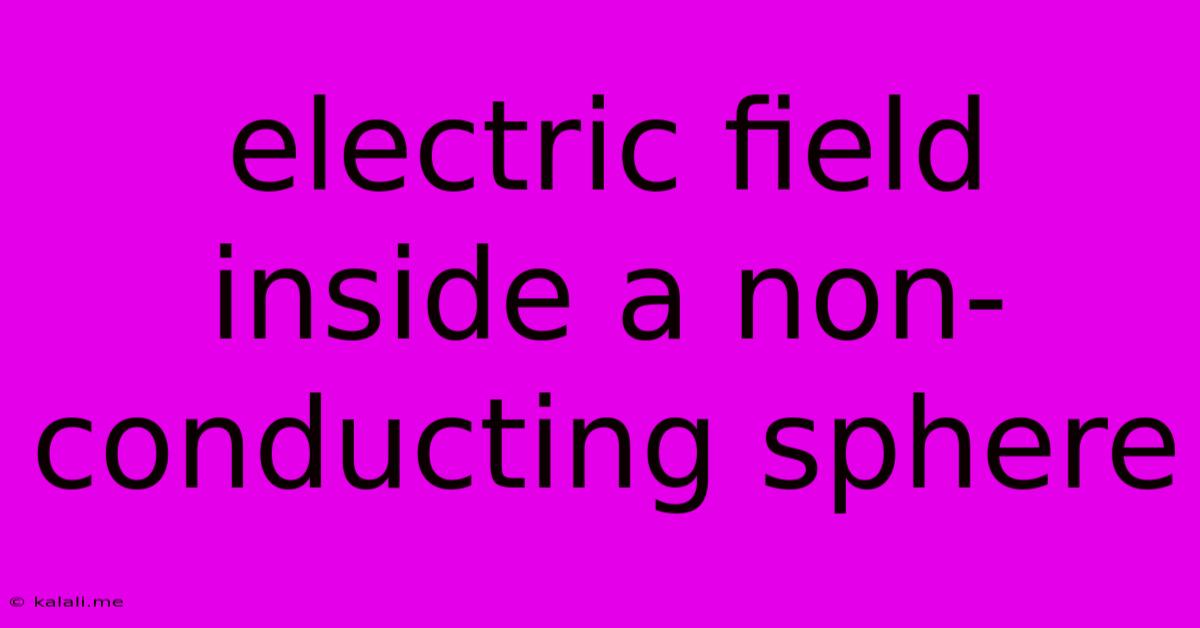Electric Field Inside A Non-conducting Sphere
Kalali
Jun 15, 2025 · 3 min read

Table of Contents
Electric Field Inside a Non-conducting Sphere
This article explores the electric field within a non-conducting sphere carrying a uniform volume charge density. Understanding this concept is crucial for mastering electrostatics and has applications in various fields, from physics and engineering to materials science. We'll break down the derivation and implications of this important principle. This guide will cover Gauss's Law and its application to this specific scenario, providing a clear, step-by-step explanation suitable for students and anyone interested in deepening their understanding of electromagnetism.
Understanding the Problem: A Non-conducting Sphere with Uniform Charge Density
Imagine a non-conducting sphere of radius R, uniformly charged with a total charge Q. Our goal is to determine the electric field at any point r within the sphere (0 ≤ r ≤ R). The crucial difference between a conducting and non-conducting sphere lies in the charge distribution. In a conductor, charges reside on the surface, while in a non-conductor, charges are distributed throughout the volume. This difference significantly impacts the electric field inside.
Applying Gauss's Law: The Key to the Solution
Gauss's Law is a powerful tool for calculating electric fields, especially in situations with symmetry. It states that the flux of the electric field through a closed surface is proportional to the enclosed charge. Mathematically:
∮ E ⋅ dA = Q<sub>enc</sub> / ε₀
where:
- E is the electric field
- dA is a vector representing a small area element on the Gaussian surface
- Q<sub>enc</sub> is the charge enclosed within the Gaussian surface
- ε₀ is the permittivity of free space
Derivation of the Electric Field Inside the Sphere
To find the electric field inside the sphere at a distance r from the center, we'll follow these steps:
-
Choose a Gaussian Surface: Due to the spherical symmetry, we choose a spherical Gaussian surface with radius r (where 0 ≤ r ≤ R) concentric with the charged sphere.
-
Calculate the Enclosed Charge: The charge density (ρ) is uniform and given by: ρ = Q / [(4/3)πR³]. The charge enclosed by our Gaussian surface is the volume of the Gaussian sphere multiplied by the charge density:
Q<sub>enc</sub> = ρ × (4/3)πr³ = (Q / [(4/3)πR³]) × (4/3)πr³ = Q(r³/R³)
-
Apply Gauss's Law: Since the electric field is radial and the Gaussian surface is spherical, the dot product simplifies:
∮ E ⋅ dA = E ∮ dA = E(4πr²)
Therefore, Gauss's law becomes:
E(4πr²) = Q(r³/R³) / ε₀
-
Solve for the Electric Field: Solving for the electric field E, we get:
E = (Q * r) / (4πε₀R³)
This equation reveals that the electric field inside the non-conducting sphere is directly proportional to the distance r from the center. At the center (r = 0), the electric field is zero. At the surface (r = R), the equation matches the electric field outside a uniformly charged sphere, which we can derive using the same approach, but with the Gaussian surface outside the larger sphere.
Key Takeaways and Further Exploration
- The electric field inside a uniformly charged non-conducting sphere is proportional to the distance from the center.
- At the center of the sphere, the electric field is zero.
- This contrasts with the electric field inside a conducting sphere, which is zero everywhere within the sphere.
- This concept forms the basis for understanding more complex charge distributions and electric field calculations.
This comprehensive analysis provides a clear understanding of the electric field within a non-conducting sphere. Further exploration could involve analyzing non-uniform charge distributions or exploring the potential difference within the sphere.
Latest Posts
Latest Posts
-
A Modulator Demodulator Is Better Known As A What
Jun 15, 2025
-
Which Of The Following Pollutants Causes Artificial Eutrophication
Jun 15, 2025
-
A Car Travels S Kilometers In 6 Hours
Jun 15, 2025
-
Lcm Of 3 6 And 9
Jun 15, 2025
-
What Is The Opposite Of Obedient
Jun 15, 2025
Related Post
Thank you for visiting our website which covers about Electric Field Inside A Non-conducting Sphere . We hope the information provided has been useful to you. Feel free to contact us if you have any questions or need further assistance. See you next time and don't miss to bookmark.